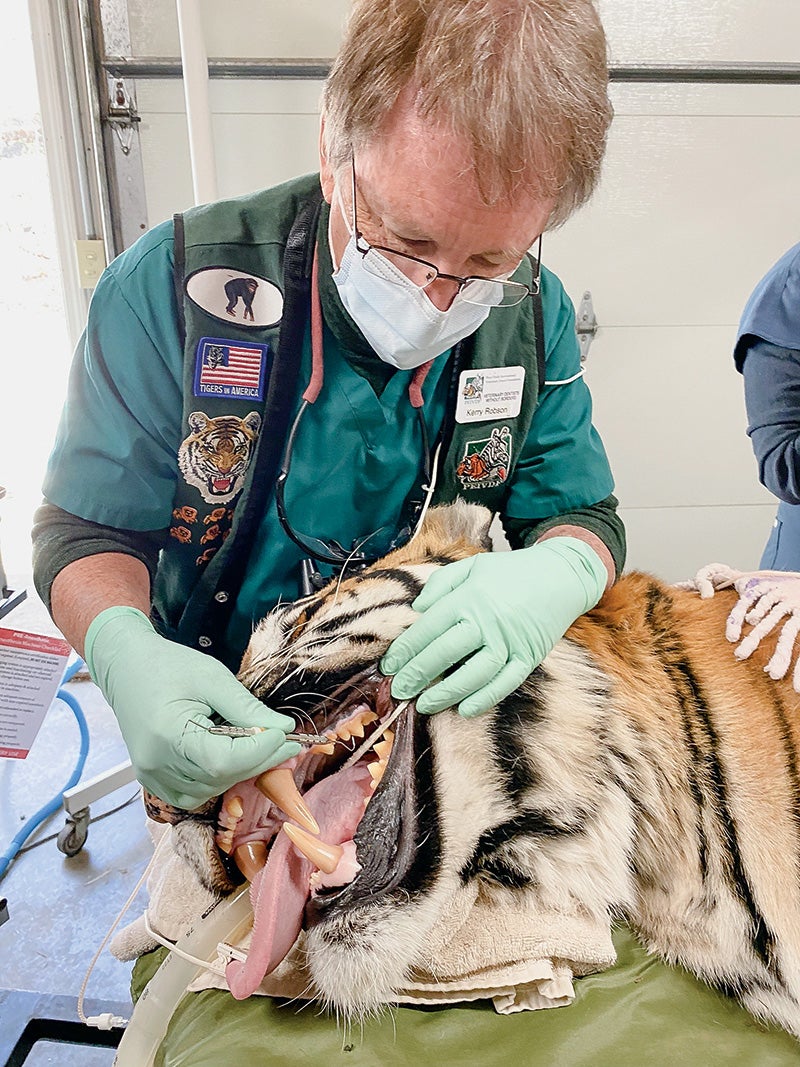connect
Working on Big Mouths
This retired dentist's patients are now lions, tigers and bears

Alumnus Kerry Robson doing a full dental examination on a Bengal tiger before performing root canals on two incisors in the tiger's lower jaw.
Kerry Robson, DDS (DEN '83), has always loved animals. As he neared the end of his career as a dentist in Palm Harbor, Florida, a decade ago, he began volunteering with the Peter Emily International Veterinary Dental Foundation. The nonprofit provides advanced dental care to exotic animals in captive facilities and sanctuaries with limited veterinary funding and staffing. Exotic animals are not domesticated or native to the United States. Now retired, Robson joins as many foundation missions as he can, paying his way to travel around the country providing care. His patients include wolves, foxes, lemurs, bears and chimpanzees, but most are big cats, such as tigers, lions, cheetahs and leopards. An alumnus of Case Western Reserve's School of Dental Medicine, Robson spoke to Think about the joys of treating patients with mouths as big as basketballs.
How did you get involved with the foundation?
I wanted to do something philanthropic. A lot of dentists will do volunteer work for humans, but I wanted to do something different. There's a big-cat rescue in Tampa that we used to take our kids to, and I learned about how they had veterinary dentists coming in to treat their cats. I thought this might be the opportunity I was searching for.
Why do big cats in animal sanctuaries need dentists?
Many of the big exotic cats we see were born and raised in zoos or sanctuaries and sometimes require dental treatment due to normal wear and tear or the occasional accident. They often won't eat because they're in so much pain. Caregivers can tell when their cats are not doing well and call us. Many, however, were brought to their new homes as a result of them being neglected. They may have come from private homes, roadside attractions or petting zoos where their canine teeth were cut down to make them more 'pettable.' Our mission is to provide them with all the dental care they require for the remainder of their life in their 'forever' home.
How is doing a root canal on a cat different than on a human?
The procedure is the same, but the instruments are a lot bigger. Another difference is that there might be two or three dentists doing up to four root canals at the same time. A big cat like a Siberian Bengal tiger—the largest exotic cat in the world—has a mouth as big as a basketball, so it can handle four hands in its mouth at once. With the dentists, dental assistants, anesthesiologist and veterinary medicine students observing, there might be 10 people around the table.
Do you get to see the cats after surgery?
Sometimes we'll go back to the same sanctuary, and I'll visit cats we worked on before. They come over and chuff at you, where they make a kind of huffing noise. with their breath. That means they're happy, they're doing well. We hear from their handlers that, a few days after surgery, the cats have started eating again and their mood has improved.
Do you have a favorite kind of cat?
One cat that's really impressive is the male African lion. They have such huge heads and teeth. I also love the Bengal tigers. I just feel very lucky to be able to work with the foundation. I have to remind myself what an amazing opportunity it is to get this close to these cats. You get so focused on the tooth you forget there's an animal attached to it. I try to remember to stand back and say, this tooth is attached to a magnificent beast.
— JENNIE YABROFF





